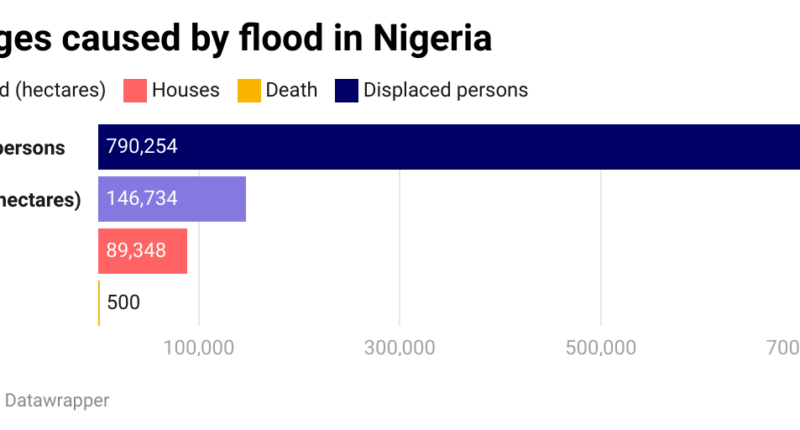The permanent secretary of the Ministry of Humanitarian Affairs, Disaster Management and Social Development, Dr Nasir Sani-Gwarzo, on Tuesday gave a nationwide report on the flood crisis plaguing 31 out of the country’s 36 states.
Driving the news
The federal official stated in his report that in the 31 flooded states and the Federal capital territory, Nigerians have lost 146,734 hectares of farmlands and 89,348 houses. Dr Nasir Sani-Gwarzo also stated that over 500 people have died while the flood has displaced about 790,254 from their homes.
The affected regions have also suffered unquantifiable economic damages, including loss of farmland, poultry facilities, livestock, etc.
- According to the spokesperson of the National Emergency Management Agency (NEMA), Manzo Ezekiel, the 2022 flooding is the highest Nigeria has seen since 2012.
Why this is happening
In September 2022, the Cameroonian authorities, in a bid to reduce the pressure and consequently release the excess water in the Lagdo dam, reportedly opened its overflow spillways.
Unprecedented heavy rainfalls along with the release of excess water from Lagdo dam thereby caused a flooding crisis in Nigerian communities along River Niger and River Benue. The flooding has resulted in the loss of lives and properties. These affected regions include Kogi, Benue, Adamawa, Bauchi, Borno, Gombe, Taraba, Yobe and other affected states.
These unfortunate events are happening despite warnings from the Nigeria Hydrological Services Agency (NIHSA) and National Emergency Management Agency (NEMA) last month.
- Cameroon has the authority to release excess water into Nigeria following a signed MOU between both countries to share information about rainfall and how to manage the release of excess water without leading to flooding.
- The MOU also instructs Cameroon to issue an early warning to Nigeria before opening its dam. This would supposedly help Nigeria put proactive measures in place to prevent flooding, which could lead to the loss of lives and properties.
- Nigeria has failed to hold up its end due to the failure of its government to build the Dasin Hausa Dam in Adamawa State to cushion the effect of possible flooding. The failure has resulted in recurring floods in the coastal regions as far back as the 1980s.
The big picture
As a result of the damage to the flooded communities and road networks, residents have abandoned their homes, motorists have been forced to take unknown or lengthened alternative routes, and farmers have lost their lands. Some socio-economic activities, including travelling, small businesses, fishing, farming and education, have halted.
Looking forward
NEMA is providing relief support to displaced persons in overwhelmed states. So far, the agency has helped over 315,000 persons.
Also, the federal government approved the National Flood Emergency Preparedness and Response Plan for Nigeria. This plan contains a detailed plan to address the flooding crisis.
What to watch
To prevent this extent of flooding crisis in the country, experts have recommended that the state government take proactive measures to curb flooding.

